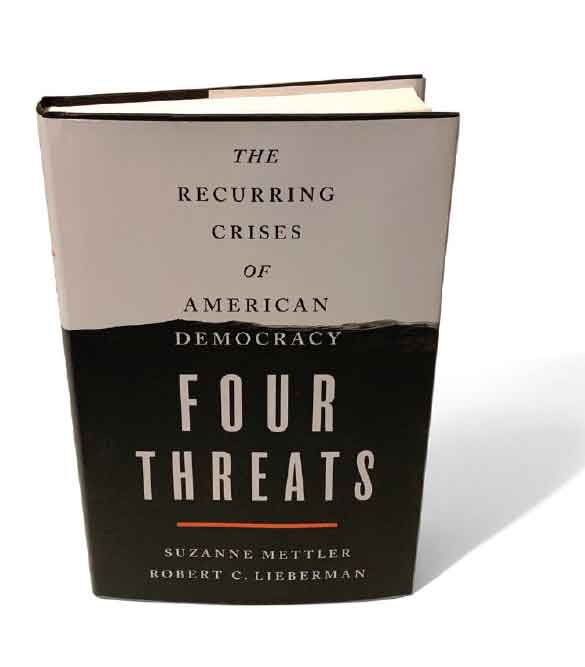
“People believe that American democracy is always moving forward,” says Robert Lieberman. “They have a sense the trajectory has always been forward. It turns out that’s not true.”
In fact, challenges to the “four pillars” of American democracy by those in power and those wanting that power have sometimes moved our political system backward, says Lieberman, Krieger-Eisenhower Professor in the Department of Political Science.
Spurred by the results of the 2016 presidential election, Lieberman and Suzanne Mettler, of Cornell University, detail when those challenges most seriously put America’s system of government at risk in Four Threats: The Recurring Crises of American Democracy.
The book suggests that the four pillars upon which an effective democratic government rests are: free and fair elections; obedience to the rule of law; a legitimate opposition that provides a healthy challenge to the party in power; and a government that protects important rights. These include the freedom of speech, freedom of religion, and freedom of the press; civil liberties such as equal opportunities for education, housing, and jobs; and voting rights.
The four serious threats to these pillars, according to the book, are: political polarization; conflict over who belongs in the political community; high and rising levels of economic inequality; and “executive aggrandizement,” the growing unchecked power of the nation’s chief executive. The book details how America faced combinations of these threats five times in its 244-year history.
The first time, in the late 1790s, featured an extreme level of political polarization fueled by bitter animosity between the country’s two major political parties. The fracture was so bad, for example, that Republicans and Federalists held competing Fourth of July parades, with one celebrating the Declaration of Independence and the other focusing on the Constitution.
In the 1930s (with Franklin Roosevelt) and again in the 1970s (with Richard Nixon), a president who sought to greatly expand his power and use it unchecked by Congress put the American democracy at risk, the authors write.
While those incidents were marked by a single threat, three threats were present in the 1850s and again in the 1890s. The 1850s were marked by a political divide so extreme that a member of the House of Representatives physically attacked a member of the U.S. Senate in the Senate chamber. During this period, a growing disparity between rich and poor and the ongoing conflict over whether Blacks should be counted as part of a state’s population and if Black men could vote combined to threaten democracy.
Following Reconstruction, a time when more than 2,000 Blacks were elected to public office, including 16 in the Congress, growing political polarization, racism, and economic inequality rose to the forefront.
Lieberman says both he and Mettler have written extensively about 20th-century American history. But during their research, they came across facts they had not known or had forgotten, he says.
“Like the Whiskey Rebellion,” he says, pointing to the uprising in southwestern Pennsylvania against the 1791 federal excise tax on distilled spirits that was brutally quelled by the U.S. Army. “Can you imagine, the president of the United States (George Washington) on horseback leading troops against American citizens?”
There was also the November day in 1898 when whites in North Carolina “would turn back decades of progress in the city (of Wilmington),” according to Lieberman. An armed mob burned down the offices of the city’s Black-owned newspaper, killed hundreds of residents of Black neighborhoods, and forced members of the biracial city government to resign, replaced by white men they had chosen beforehand.
“That is an amazing story,” Lieberman says. “The coup in Wilmington was just that, a coup.”
The book contends that unlike those past five instances, today for the first time in its history, all four threats to American democracy are present. “Decades of the ascendance of the four threats gave rise to the candidacy of Donald Trump, a political neophyte seemingly ignorant of and uninterested in public policy and the process of governance,” the authors write.

“It’s not a Trump book. It’s a book about the conditions that gave rise to the Trump presidency. Donald Trump and the Trump presidency are symptoms of a deeper challenge to American democracy.”
—Robert Lieberman
Following Trump’s election, Lieberman and Mettler, long-time friends, joined two faculty members at Cornell University and another at Swarthmore College to form the American Democracy Collaborative. Ideas for the book grew out of this collaborative.
In addition to input from the collaborative and his Hopkins colleagues, Lieberman credits feedback from the students in his 2019 seminar on “The Future of American Democracy” and those in the Program on Social Policy. “Supersmart, energetic, talented undergrads. They were incredibly helpful,” he says.
He says feedback from faculty, students, and others often included the question, “How do we get out of this?” It is a difficult one to answer, he says. America survived its five earlier crises at a cost of reinforcing or restoring racial hierarchies and imposing limits on the political community. That cannot be acceptable this time, the authors note.
“Something that gives me optimism is the Black Lives Matter marches,” Lieberman says, pointing to the numerous protests around the country last summer at locations often not directly associated with recent racial injustice. “There’s a glimmer of hope, a possibility of something changing.”




